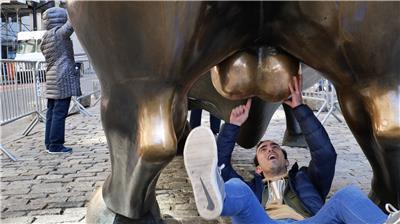
Caption
A man on his back examines the Wall Street bull statue's testicles in New York City as part of a campaign to raise awareness about testicular cancer.
Credit: (Photo via AP: Alejandra Guerrero; Rodrigo Guaxupe; Rodrigo Burdman)
LISTEN: Clinical trials throughout Georgia are testing new ways to prevent, detect, diagnose, or treat testicular cancer. GPB’s Ellen Eldridge reports.

A man on his back examines the Wall Street bull statue's testicles in New York City as part of a campaign to raise awareness about testicular cancer.
Mike Craycraft found himself facing his own mortality in his early 30s, when he noticed an unfamiliar feeling in his scrotum.
"I just went to adjust myself, felt a lump and immediately thought it was cancer," he said. "But then went into a vicious cycle of probably fear, denial, not really not wanting to upset others and ignored those symptoms for seven months."
The clinical pharmacist endured emotional distress while telling himself he would see a doctor, eventually.
"I convinced myself I was going to die from metastatic disease (and) threw my own going away party," Craycraft said.
While returning to his hometown of Cincinnati for Thanksgiving and a wedding, his fear drove him to say goodbye to his loved ones — before he received a diagnosis.
"I didn't know how to show up in town and say, 'Hey, I have cancer' or 'I'm going to die,'" he said. "So I threw a party and didn't tell anyone why and figured that, you know, in a couple of months they would find out that that was my feeble attempt to see everyone one last time."
When Craycraft did, finally, see a doctor, he was diagnosed with stage 1 testicular cancer, which is 99% curable.
He said that most testicular cancer presents as a painless lump on the testicle itself.
"You can have a testicle that increases in size or decreases in size, or you can just have a general feeling of heaviness in your scrotum," he said.
Craycraft went on to found the Testicular Cancer Society to help save lives through early intervention.
Four in 10 American men aren't checking themselves, Craycraft said, noting that half of 25 to 34-year-olds don't even know what to look for.
Lump or firm area within the testicle
Painless swelling or enlargement of the testicle
Pain or tenderness in the testicle
Dull ache in association with the lump.
Along with MANSCAPED, the organizations launched the "most checked balls on earth" campaign centered on the idea that people travel from all over the world to see — and touch — the testicles of the Wall Street bull statue. The bronze statue's anatomical features have been rubbed so much that they're now a burnished gold color.
"It's ironic that people will line up by the droves to check out the Wall Street bull and its balls and yet don't want to check their own," Craycraft said. "So, hopefully, we can, you know, use some humor and get people to realize the irony of that and promote an environment of self-examination."
When speaking about awareness, 79% of respondents agreed that there needs to be more testicular cancer awareness, Craycraft said.
"You hear breast cancer all the time, but you don't hear anyone say 'testicular cancer,'" he said. "And if they do, it's usually hush-hush. And that's a shame. We're trying to fix that."
MORE ON BREAST CANCER
Breast cancer is the most common and deadliest cancer among Georgia women, killing an estimated 1,400 people in 2022.
Testicular cancer, alternatively, is relatively rare, affecting around 9,600 Americans each year, when abnormal cells in the testicles multiply rapidly and form a mass or tumor.
The American Cancer Society estimates about 220 new cases among Georgians during 2022.
Treatment almost always includes removing the testicle with an orchiectomy procedure, and a urologist may offer implant options to maintain the look and feel of the scrotum after treatment.
Depending on the stage of the cancer and the time of diagnosis, a doctor might recommend radiation and chemotherapy to ensure all cancer cells are destroyed.
The success rate for testicular cancer treatment is high, and most patients make a full recovery.
Monthly self-examinations are recommended to monitor any changes in the testicles themselves. Any lumps or growths should be inspected immediately.
The average age of a testicular cancer diagnosis is 33, and is most commonly discovered among white people between 15 and 34.
Clinical trial locations are available in Atlanta, Macon, Savannah, and Augusta among others.